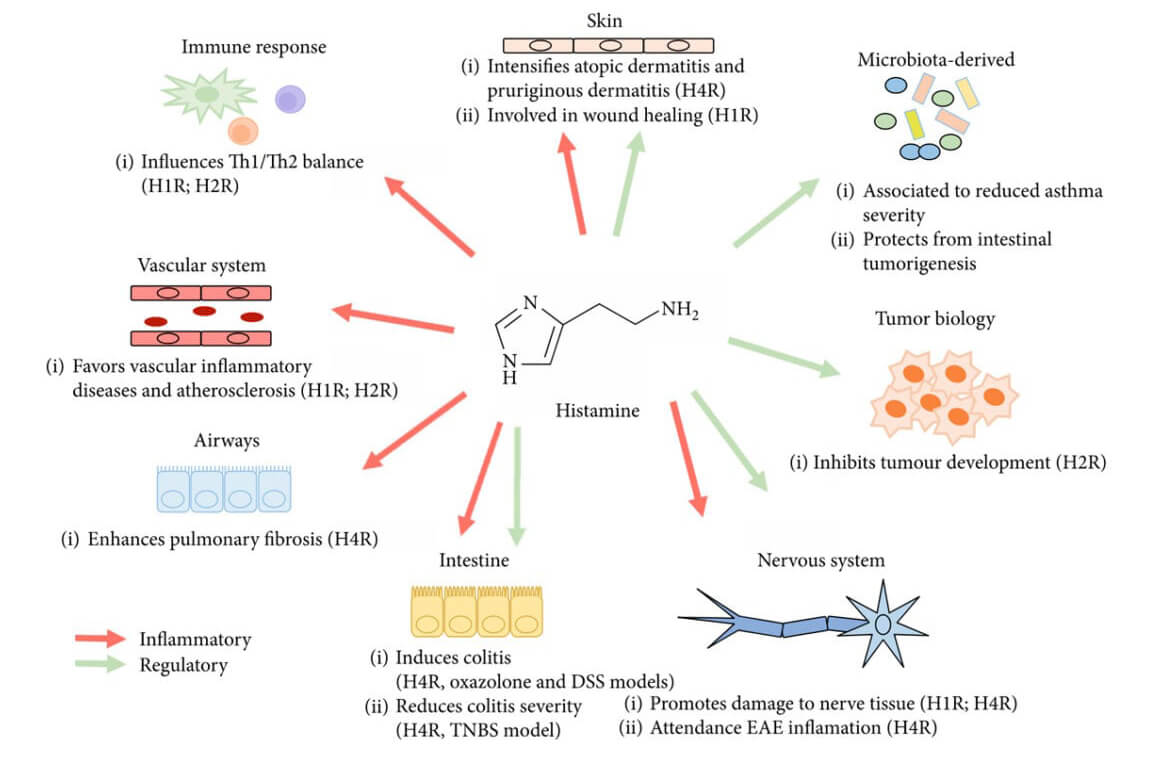Table of Contents
What is histamine
Let’s talk about seasonal allergies, pollen in the environment and why certain people do not enjoy spring or are hypersensitive to grasses and mites… If we delve into this question, we come to histamine, the substance behind many processes related to hives, runny nose, excess mucus, and allergic inflammation. Let’s see why.
One of the most revealing issues is that, despite what one might think, histamine is a substance present in the tissues of our body. In the late 1920s, a group of researchers found this compound in various tissues of our organs, a milestone from which it derived its name histós, which means “tissue” in Greek.Spinning thinner, we can say that histamine is found naturally in the cells of our immune system, specifically mast cells and basophils (among others). According to research, it is a fundamental mediator of the allergic response.
PROFESSIONAL AREA | We have the best training resources in Mycology applied to health.
Of note: at the biochemical level, histamine (C 5 H 9 N 3 ) is classified as an amine (it has the structure of ammonia (NH 3 ) and is formed from the elimination, in the form of CO 2 , of compounds of amino acid histidine carboxyl.

What functions does histamine have?
As explained by the Spanish Society of Clinical Immunology, Allergology and Pediatric Asthma (SEICAP) on its website, when a person reacts to common allergens such as pollen, mites, etc. produces IgE (immunoglobulin E) antibodies against that substance. If said allergen enters the body, antibodies bind to it and can trigger the release of substances such as histamine, which may be responsible for the appearance of symptoms such as coughing, hoarseness, wheezing, sneezing, itching, tearing, reddening of eyes, hives, inflammation…
Mast cells and basophils are immune cells very present in the skin and mucous membranes. These are responsible for storing histamine-containing granules released in response to various stimuli. Immunoglobulin E (IgE) is a molecule promoting histamine release.
Research carried out in the 1930s allowed progress in developing the first antihistamines. These drugs block the effects of histamine but also allow more details about histamine to be discovered. The sedative effect derived from them determined that histamine not only has to do with the immune response but also intervenes in the central nervous system (CNS), where it participates in regulating various functions such as sleep, locomotor activity and even in memory and learning.

What are its effects?
- H1. Location: smooth muscle, endothelial cells, medulla of adrenal glands, heart, and CNS Main effects of receptor activation: allergic responses, smooth muscle contraction, hormone release, and regulation of the sleep-wake cycle
- H2. Where it is located: gastric parietal cells, smooth muscle, suppressor T cells, neutrophils, heart, uterus, and CNS Main effects of receptor activation: stimulation of gastric acid secretion, relaxation of smooth muscle
- H3. Where it is located: CNS and nerves to the heart and gastrointestinal tract Main effects of receptor activation: inhibition of the synthesis and release of histamine and other neurotransmitters
- H4. Where it is located: bone marrow, leukocytes, neutrophils, eosinophils, mast cells, and lung

Published evidence shows that people with low activity of this enzyme cannot break down the exogenous histamine we consume from our food. This excess could cause migraines and other symptoms that we have already discussed, such as intestinal problems, atopic skin, fatigue, etc., because it would unleash the processes we explain in the receptors.
Why is there talk of histamine-releasing foods?
One of the guides prepared by the SEICAP indicates that certain foods that contain substances such as vasoactive amines such as histamines can trigger symptoms that, without being so, could be confused with an allergic reaction. They call it “false allergising foods, ” although they are foods considered to release histamine. Among others, these are the foods mentioned by the medical society:
- tuna
- chocolate
- strawberries
- tomato

Why do we talk about histamine in allergies?
One of the first lines of research on histamine was its involvement in allergic responses. According to research carried out by Lewis (1924), the release of histamine gives rise to a triple response in which the following are common:
- central erythema
- oedema
- peripheral erythema
According to the review published in 2009, this triple response is mainly involved in H1 and H2 receptors. The aforementioned erythema can cause reddening of the skin, a drop in blood pressure and peripheral resistance. In addition, when the H1 is activated, the conditions for oedema and pruritus are produced.
As a result of this research, antihistamines were developed, capable of blocking H1 receptors and with positive results in rhinitis, conjunctivitis, pruritus, and atopic dermatitis…
What are antihistamines
These drugs base their effect, fundamentally, on the blockade of H1-type histamine receptors which, as we have seen, has consequences on the allergic response, smooth muscle contraction, hormone release, and regulation of the sleep-wake cycle.
First and second-generation antihistamines
First Generation
The first-generation drugs are lipophilic, capable of easily entering cells. Consequently, its absorption and metabolization is rapid, so it must be administered frequently, 4 or 4 times a day. They also cause significant side effects, such as sedation and seizures.
Second Generation
On the other hand, the second generation ones have been developed in the last 25 years. Some derive from the first generation, but with a clear difference: the reduction of sedative and anticholinergic effects . Despite this, they are not exempt from side effects, especially if they are administered with other drugs.
Why talk about the relationship between histamine, allergies and the digestive system?
We already know that histamine is a mediator in allergies but is also involved in inflammatory bowel disease. This is underlined by an article published in 2005 in which, in addition, high levels of histamine were observed in patients with Crohn’s disease and ulcerative colitis. Among other arguments, the authors argue that three of the four histamine receptors were discovered in the digestive system, showing that this amine could have acted on the intestinal tract. More specific investigations on the type of H1 receptor have confirmed that histamine might be responsible for diarrhoea in inflammatory bowel disease and food allergies.

Are there foods and/or compounds with antihistamine capabilities?
Beta-glucans
These polysaccharide compounds present in foods such as mushrooms, certain cereals and algae have been studied mainly for their action on the immune system. A study published in the Food Science & Nutrition magazine observed that supplementation with formulas with beta-glucans reduced allergy symptoms by 28% and their severity by 52%. The conclusions of this study also indicated overall improvements reported by trial participants. They pointed out improvements in sleep disorders, energy levels and reduction of symptoms related to runny nose, red eyes, congestion, etc.
Bromelain
A study published in 2013 showed that this enzyme present in pineapple could reduce sensitization to allergic processes in which the airways are involved, thanks to its anti-allergic and anti-inflammatory action.
Quercetin
This compound is found in many foods of plant origin, but it stands out in broccoli, apples, grapes and tea. Quercetin stands out for its antioxidant capacity. According to the study Quercetin and Its Anti-Allergic Immune Response, published in 2006, quercetin can reduce the release of histamine and contribute to the reduction of inflammatory processes.
Vitamin C
Several studies have evaluated the relationship between vitamin C and histamine metabolism. An article published in 2015 indicates that ascorbate has a unique ability to break down this substance. Previous publications on human trials show that taking vitamin C significantly lowers plasma histamine levels . In animal models, the decrease in bronchoconstriction caused by histamine has even been documented.
In summary…
Histamine is more than a substance involved in inflammation and allergy. In this brief review, we have highlighted some scientific articles in which its role as a neurotransmitter, hormone and regulator of the immune system would be demonstrated.
WE RECOMMEND

Linoleic Acid: Why This Essential Omega-6 Is Vital for Your Health
☑️ Linoleic acid is a polyunsaturated omega-6 fatty acid essential for human health, as the body cannot synthesise it and must obtain it through diet. This fatty acid plays several critical roles, including supporting skin integrity, contributing to the formation of cell membranes, and serving as a precursor to important bioactive compounds. Its anti-inflammatory properties and role in maintaining the skin barrier make it particularly beneficial for skin health. Understanding the importance of linoleic acid and ensuring adequate intake can significantly impact overall well-being.

Are all red mushrooms toxic?
Red mushrooms are often perceived as toxic, but sometimes other properties are also recognised. Let’s discover them together in this post.
